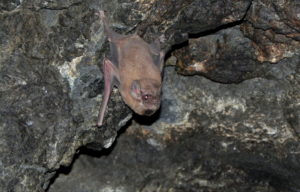
Hi everyone! I hope you all had a good week. My week had a sad start because the Nature Fest in Herndon was cancelled because of the rain. It rained pretty much all week, but I think we are supposed to have a sunny weekend. There was another earthquake in Indonesia on Friday. And then after the earthquake there was a tsunami. I would like to dedicate this week’s blog to the people of Indonesia. My thoughts are with you all while you recover from these events. I researched Indonesian bats and I found an absolutely adorable one! It is called the Black-bearded tomb bat. They have a face that reminds me of a shrew with a beard. Its face points outward and they have big round ears on top of their head. Their fur is brown with a little bit of gray and sometimes even red. The dense fur covers most of their body, but it stops before it covers their face. I think this makes their fur look slightly mane-like. The male Black-bearded tomb bats have seasonal black-ish brown beards that they grow to attract mates. Black-bearded tomb bats are found in a variety of places including Indonesia, China, India, Malaysia, Singapore, Vietnam, and Thailand. They roost in rainforests, woodlands, and abandoned buildings. They roost near where they can find their favorite foods. They eat insects like many other bats, but they also enjoy munching on fruit. If you would like to learn more about these bats, you can find information here and here.
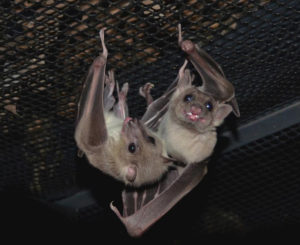
Hi everyone! I hope you all had a good week. I was looking up interesting bats from around the world and found a really adorable one called the Rousettus Bat. Rousettus bats are also more commonly known as Egyptian Fruit Bats. These bats have orange-yellow fur around their necks that match nicely with the dark brown and gray fur along their backs and stomachs. Rousettus bats are found in the tropical rainforests, savanna, and tropical deciduous forests in Africa. They are also found in scrub forests of Mediterranean Turkey. Egyptian Fruit bats eat a lot of fruit each night. They like to eat soft, pulpy fruit, especially wild dates. They also eat unripe fruit and fruit damaged by insects or fungus. Because they eat this fruit, they are able to survive when ripe fruit is not available. If you would like to read more about the Rousettus bat, you can find information here. And now for the exciting news! Herndon Nature Fest is tomorrow afternoon from 1 – 5 PM. It is being held at Runnymede Park, 195 Herndon Pkwy in Herndon, VA. Save Lucy’s President, Mrs. Sturges, will be there with some bats and I will be there too! If you are in the area, I hope to see you there. Have a good week!
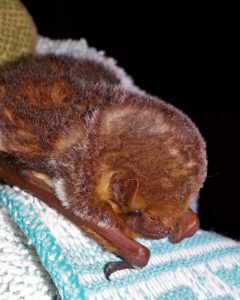
Hi everyone! I hope you all had a good week. Mine was pretty good. People in the Carolinas are having a really hard time though. Hurricane Florence made landfall yesterday and is causing a disaster in North and South Carolina. This week’s blog is dedicated to the people of North and South Carolina. I hope they are able to stay safe during the storm and are able to return to their homes soon. I researched a bat that lives in the Carolinas. It is an adorable bat species called the Seminole bat. The bats are found in a wide range. They live in the forested regions of eastern Texas, north to southeastern Oklahoma, central Arkansas, Mississippi, Tennessee, Georgia, North and South Carolina, and into south-central Virginia. And, if you’ll remember, there were a few Seminole bats found in Northern Virginia not too long ago. These furry little critters have an interesting place that they like to roost. They roost in Spanish moss! They also like loose tree bark that they can squeeze under. A lot of their roosts are in dark locations where they can drop down into flight. The Seminole bat has mahogany colored fur with silver-ish tips that give the bats their beautiful reddish coloring. The Seminole bat eats insects. They especially like leafhoppers, flies, beetles, bees, and ants. If you would like to read more about these bats, you can do so here.
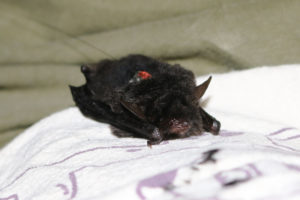
Hi everyone! I hope you all had a good week! The best part of mine was the holiday on Monday. It was nice to sleep late and relax. There was a powerful earthquake in Japan on Thursday. I would like to dedicate this week’s blog to the people of Japan. My thoughts are with you all as you recover from this earthquake. I read about an adorable Japanese bat called the Yanbaru Whiskered bat. These bats have black fur over most of their body, with some hairs having silver colored tips. This bat was first discovered in 1996 and has been listed as critically endangered by the International Union for Conservation of Nature. This is because its habitat is only 39 square miles of land. The Yanbaru Whiskered bat is only found on a few of Japan’s islands: three of the islands of the Ryukyu Archipelago, Okinawa, Amami Oshima, and Tokunoshima. This bat roosts in hollow trees. Because this bat’s habitat range is so small, deforestation is a major threat. If you would like to read more about the Yanbaru Whiskered bat, you can find information here. As you are making your plans for the rest of the month, please consider attending Herndon’s Naturefest. It will be on September 23 from 1-5:00 at Runnymede Park in Herndon, VA. Save Lucy’s esteemed leader, Mrs. Sturges, and I will both be there. And best of all, Mrs. Sturges will bring some of our batty friends. I hope you all have a good week.
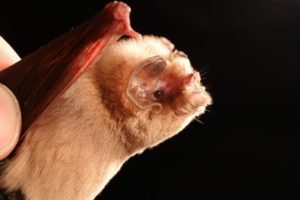
Hi everyone! I hope you all had a good week. It was the first week of school for me. For the most part, it was pretty good, but I do miss sleeping late every day. Arizona Senator John McCain passed away on the 25th. He was a senator for 31 years, before that he served two terms in the US House of Representatives. He also served as a Naval pilot in Vietnam where he became a decorated war hero. This week’s blog is dedicated to Senator John McCain. My thoughts are with his family. I decided to write about a bat from Senator McCain’s home state of Arizona and found a very interesting looking one called the Ghost Faced Bat. This bat gets its name from the way they look. Unlike a lot of other bats, the ears of a Ghost Faced bat join at their head. The ears are large and round and connect to the head near their cheeks. This makes their eyes look smaller than usual and appear to be inside of their ears! The also have leaf shaped flaps of skin that protrude from their chin. They are very handsome! Unlike a lot of bats, these bats live in places that don’t get too cold during the winter. For this reason, they don’t hibernate and are active year-round. And because they are content where they are, they don’t migrate either. These bats live throughout Mexico, Texas, Arizona, and into Central America. Their habitat is desert scrub and they roost in caves, abandoned mines, tunnels and old buildings. They eat insects like all other bats in the United States. Instead of foraging near water, they hunt for their flying dinner far above ground. If you would like to read more about these amazing bats, you can find […]




